|
Related Websites
Waterwear Guide
Clothes for Wild Watersports
waterwearguide.com
Sports Nutrition and Weight Control
vitaminbiz.com
Free Lifesaving Society
Get free lesson plans for survival swimming and lifesaving
freelifesavingsociety.com
Clothes for Swimming
Guide to a wide variety of swimwear
swimwearguide.com
|
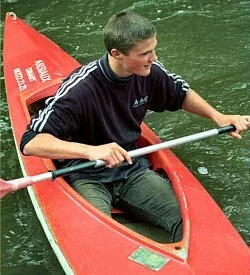 |
Kayak Wet Exit
|
Look forward to a couple of capsizes (swims) during your learning period and later on. The more you practice the capsize drill the better you'll be prepared for when it happens unexpectedly.
About 75% of accidents are classified as "capsizes" by the Coast Guard. Statistically, capsizes appear to be as likely on calm water as on choppy or rough water. So get ready and be safe.
For your first attempt choose a area of calm, sheltered water and enlist a friend for support. Wear robust, but soft clothes so you don't scrape your skin on the boat.
|
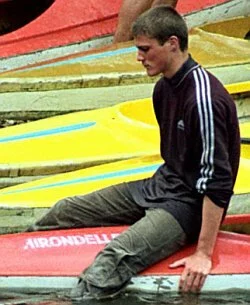
Practice balancing until you get a feel for it.
|
Keep Your Balance |
-
Get a feel for it.
Sit on top of the boat, just in front of the seat opening, with your legs in the water for stability. Sitting on top raises the centre of gravity and makes to boat more prone to tipping over. Keeping your balance will be slightly easier whilst your clothes are still dry. Wet clothes add a fair bit of weight, so try to stay dry as long as you can. Eventually you get wet anyway.
-
Slowly raise your legs.
Bring up your legs to the side, towards the deck, until you lose your balance and fall into the water. Repeat until you get quite good at keeping your balance.
-
Stand up in the boat.
Climb in and try to stand up in the cockpit. See how long you can stand up before you fall in. Once you've mastered this, fill some more water into the boat and try again.
|
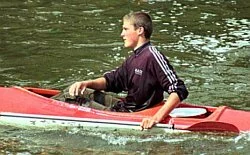
Prepare to capsize.
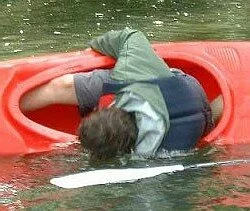
Lean over until you fall in.
|
Practice the Wet Exit |
-
Prepare your capsize.
It is natural for you to feel some apprehension and excitement before to your first wet exit so you may want to do the first one without the spray deck in place.
-
Find the point where the boat tips over.
Sit inside and lean over slowly to get feel for the boat's stability. Each time lean over a bit more until you capsize.
-
Turn all the way upside down.
Now push yourself out towards the back of the boat. Empty the boat and get back in. Repeat this until you can lean over only so far that you don't fall in. Some people feel somewhat apprehensive about getting stuck in the cockpit. This is not a problem. The trick is actually staying in the cockpit. Without thigh braces and padding you will fall out of the boat. It is difficult to convince beginners of this.
-
Add more clothes.
As you gain more confidence add more clothes to add more weight and make it more difficult. You'll find this an interesting challenge as adds more realism to your training.
|
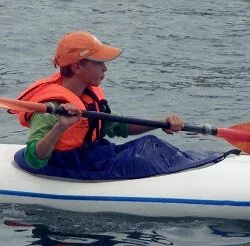
Boats with long cockpit are easy to get out of, even with a spray deck.
Turn your boat over and get out.
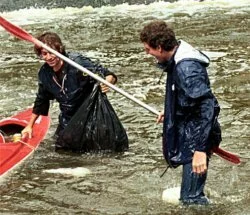
Ask friends to help empty the boat.
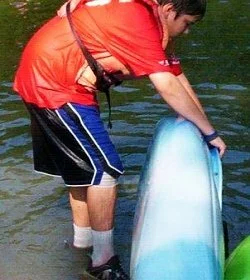
Take turns with capsizing or you'll be exhausted too soon.
|
Practice the Wet Exit with Spray Cover |
-
Locate the quick release strap.
Before you do anything else make sure the release strap for the spray skirt is on the outside of the boat. If its tucked into the boat it will be very hard to pull off the spray-skirt.
-
Take a breath, lean over and capsize.
Once you are ready, take a deep breath and slowly roll yourself into the water. Once you are underwater let go of you paddle.
-
After you let go of your paddle take a second to get your bearings. When you get under water you may feel disorientated for a moment. Get used to it and learn to handle it.
-
Sit still until you are completely upside-down.
Hanging upside-down for these few added seconds will give you confidence so that you will not panic when you need to remove the spray deck.
-
Bang three times on the upturned hull.
Hit it with your hands before getting out. This will also be a signal to your friend that you are in complete control of the situation.
-
Grab the quick release strap.
Now that you are turned over and underwater, reach around with your hand until you grab the release strap on your spray skirt. It doesn't matter whether or not you can open your eyes. Most people find the strap by groping for it.
-
Pull the quick release strap.
After you get the strap in your hands, you will want to pull it toward the front of the boat and then up to make sure it clears the coaming. Once you do this and let go the whole skirt should come off by itself.
-
Lean forwards and straighten your legs.
The first thing you want to do is lean forward to help keep your body from hitting things in the water. Next you will take your hands and place them on the boat beside your hips where you can get a good grip. Place both hands behind you on either side of the boat. Push yourself out of the seat towards the stern (back) of the boat. The first movement of your exit is like taking off a pair of trousers, you lean forwards. Nobody leans backwards when they remove their pants!
-
Push out and backwards.
Next you need to straighten out your legs and push up with your arms. This will move you out of the boat. After you get your arms straightened out you then want to push back so that your start to slip out of the boat. This is the final motion to get out of the boat.
-
Grab your boat
Once on the surface, grab the boat's toggle and then retrieve the paddle, taking the boat with you. Hold on to the nearest lifting toggle while you swim to the paddle and you will find the boat easy to tow; it will also help to support your weight.
-
Hold on to your boat
If you let go of the boat even for an instant the wind may blow it away faster than you can swim after it. In a river stay at the upstream end of the canoe so that if the canoe becomes pinned, you don't.
-
Flip your boat upright
Now turn the boat upright in a way that it doesn't take on too much water. A quick flip over usually does it.
|
|